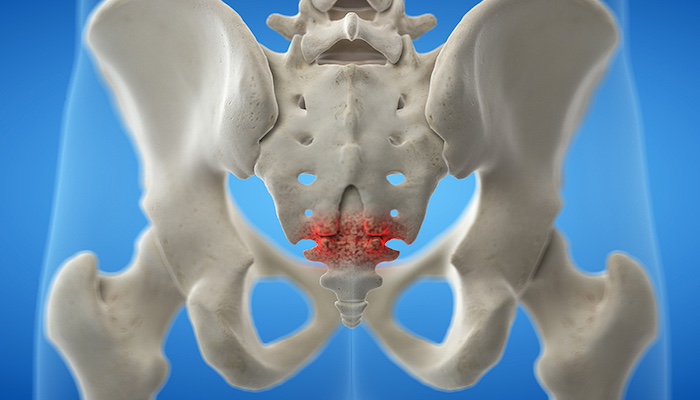
Coccydynia is typically diagnosed by gathering a thorough medical history and completing a physical exam. These two standard diagnostic practices are usually sufficient in obtaining a diagnosis and evaluating treatment options, but in some cases, diagnostic tests such as scans or injections may be used.
Initial Diagnostic Methods for Coccydynia
A complete medical history collected will likely include information on current symptoms, as well as when and how symptoms developed. A doctor may also look for environmental or lifestyle factors for the patient’s pain, such as recent injury, exercise habits, or obesity.
After a medical history is collected, a doctor will begin a physical exam. A thorough physical examination for coccyx pain may include:
- Palpation to check for local tenderness. A doctor will feel by hand (called palpation) to identify swelling and tenderness around the coccyx. Palpation may also be used to identify potential coccygeal spicules (bone spurs), cysts, or tumors.
- Intrarectal exam and manipulation. In some cases, a doctor may choose to manipulate the coccyx manually through the rectum, to assess limited or excessive mobility of the sacrococcygeal joint. Intrarectal manipulation may also be used to assess any muscle tension in the pelvis connecting to the coccyx.
The most consistent finding on examination is usually tenderness upon palpation of the coccyx. If the coccyx is not tender to palpation, then the pain is likely referred from another part of the spine.
Diagnostic Tests for Coccydynia
Diagnostic tests are usually not needed for coccyx pain. In some cases of severe, unrelenting pain, a diagnostic test may be used to determine how pain is being caused and how it can best be alleviated. Diagnostic tests for coccydynia may include:
- Dynamic X-ray imaging tests. While there is some debate over the efficacy of imaging tests for diagnosing coccydynia, it is generally agreed that dynamic X-ray imaging is helpful. A dynamic X-ray produces two images—one of the patient sitting and another of the patient standing. A doctor will compare the images and measure the angle of pelvic rotation as well as the coccyx’s change in position from sitting to standing. If these measurements are outside of the normal range (between 5 and 25 degrees), too much or too little coccygeal movement can be identified as the cause of pain.
- Coccygeal discogram. Similar to the same procedure done on the lumbar spine, a coccygeal discogram consists of an injection of local anesthesia in the sacrococcygeal region. The injection targets a specific area in the spine, such as an intervertebral joint or disc, to identify the precise location where pain is being caused.
- CT or MRI scans. A static image of the coccyx taken by MRI or CT scan (one that does not illustrate pelvic rotation or movement) may be used if the suspected cause of pain is a fracture, tumor, or abnormal mobility of the sacrococcygeal joint. Static images, however, are usually not helpful for diagnosing coccydynia and are used sparingly when a source of coccydynia cannot be identified using other means.
In rare cases, routine blood tests are obtained to rule out the possibility of an infection or tumor. A doctor may also order a guaiac stool test to determine if the issue has its origin in the gastrointestinal tract.
Precision Pain Care and Rehabilitation has two convenient locations in Richmond Hill – Queens, and New Hyde Park – Long Island. Call the Queens office at (718) 215-1888 or (516) 419-4480 for the Long Island office to arrange an appointment with our Interventional Pain Management Specialists, Dr. Jeffrey Chacko or Dr. Sonny Ahluwalia.















